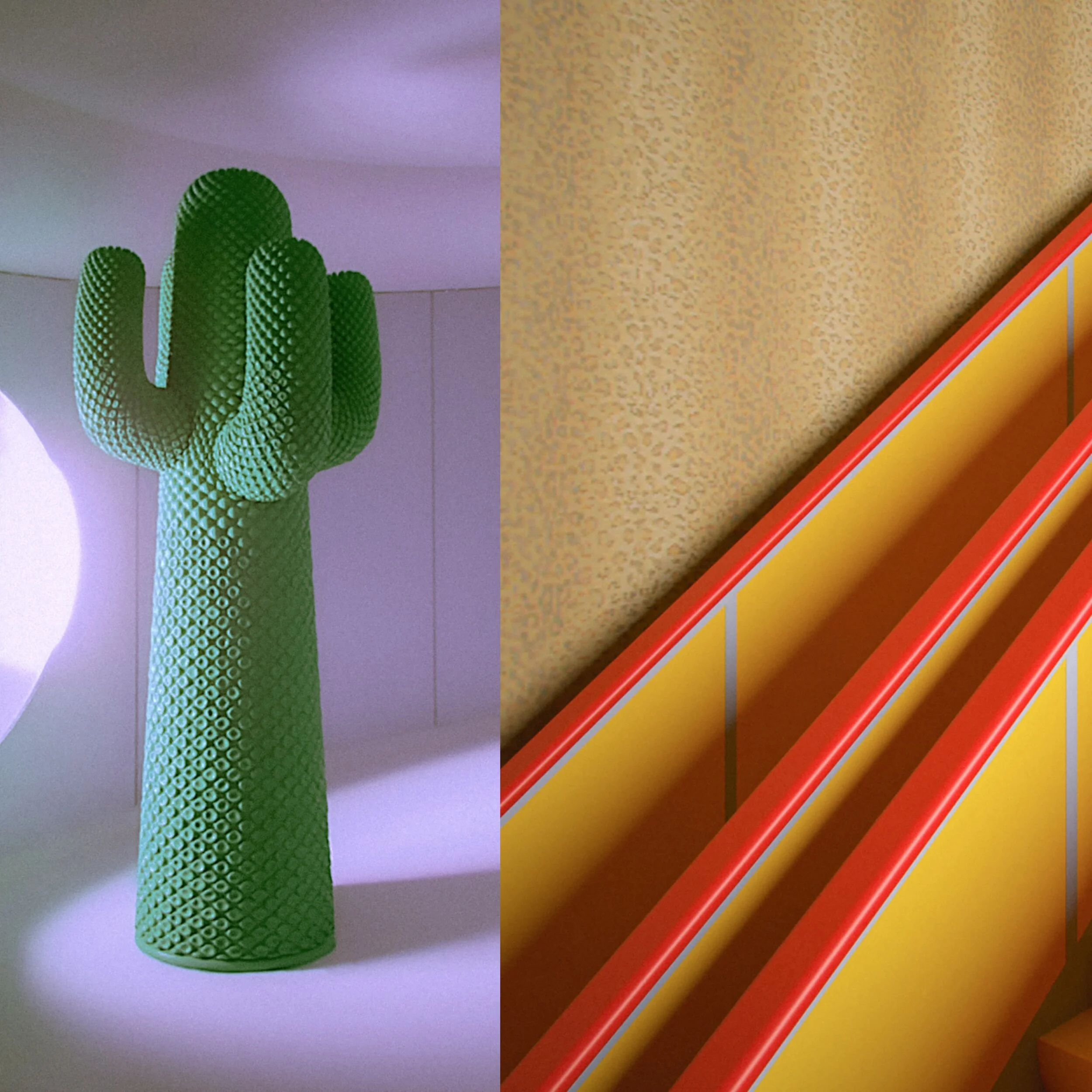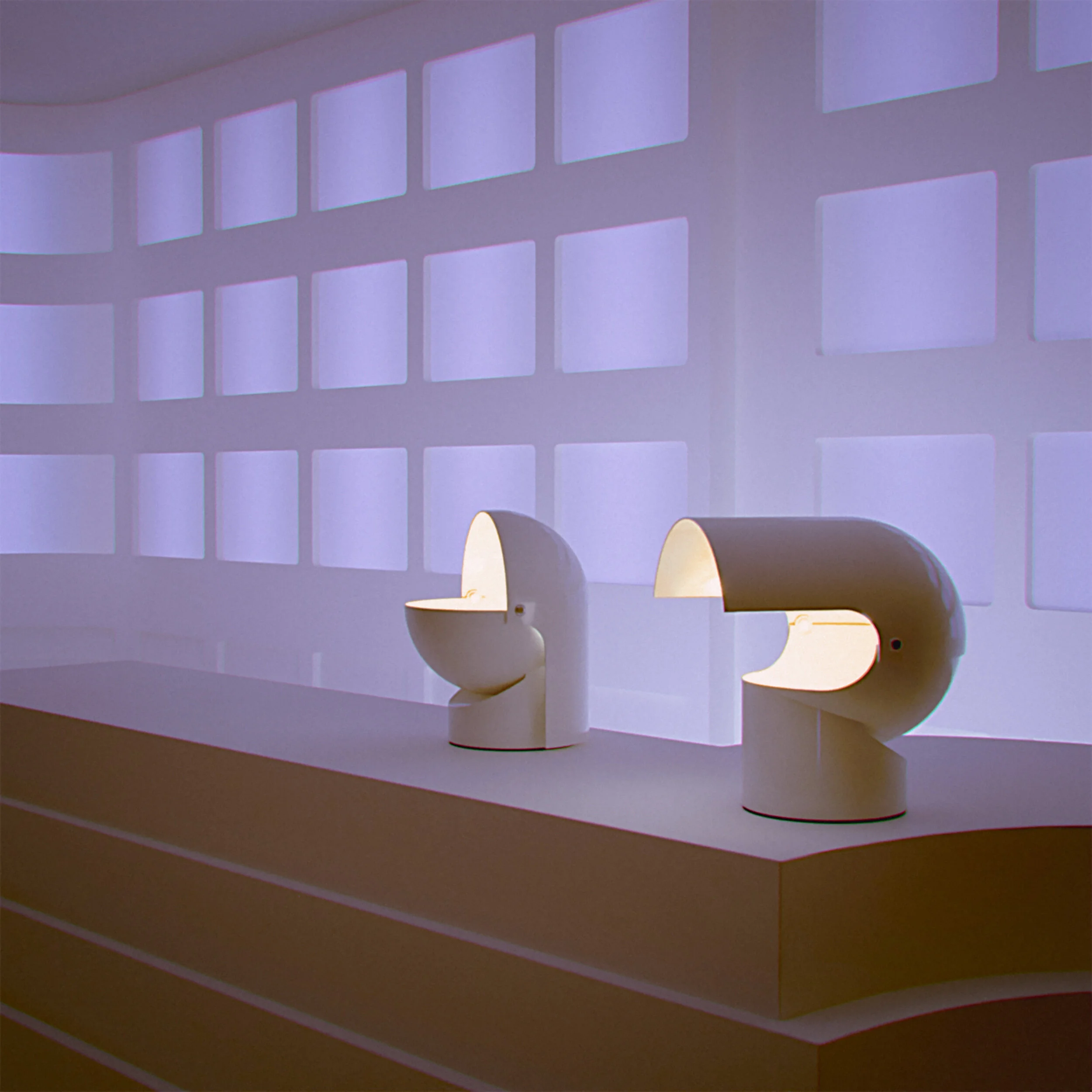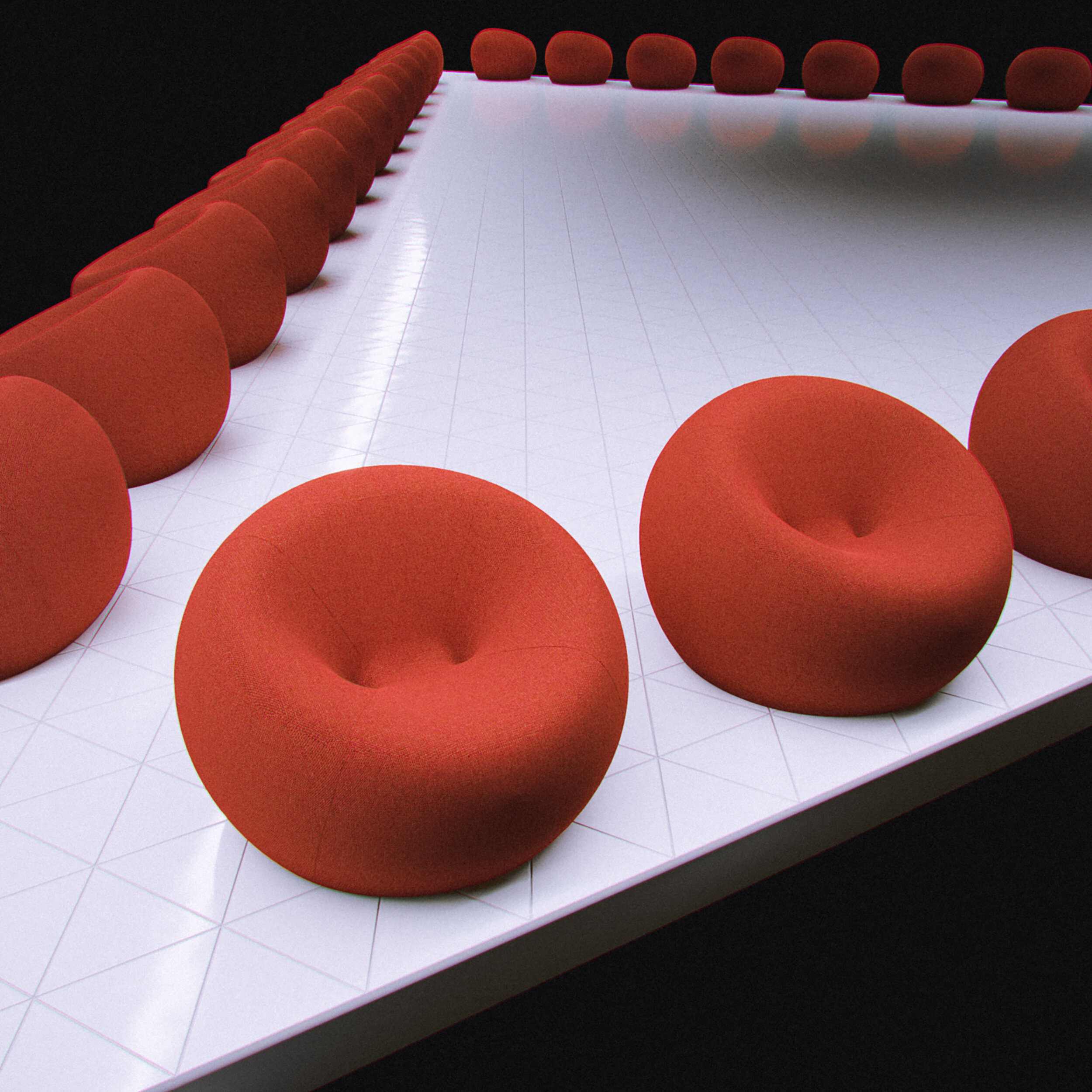Exhibitions
Different Tendencies
Italian Design 1960-1980
“Let us regard the ‘radical’ movement not as some monolith, but rather as a reality made up of different tendencies which, over time, have given rise to completely different results.”
— Andrea Branzi, No-Stop City: Archizoom Associati
Superhouse is pleased to present its second exhibition, Different Tendencies: Italian Design 1960-1980, which highlights over 40 works for sale from the Radical period of Italian design. For the first time, view these classic and rare works rendered in stunning 3D.
With a nod to the unconventional spirit of the nearly 30 artists, designers and architects on view, the show takes an experimental approach. Superhouse commissioned Duyi Han to craft virtual landscapes suitable for these important pieces. Han’s 40 dreamy scenes and video are packed with contemporaneous cultural references to Pop Art, album covers, films, nightclubs, the design of the Museum of Modern Art’s seminal 1972 exhibition, Italy: The New Domestic Landscape and more.
Tour the exhibition through the video above and scroll down to view detailed vignettes and read text by Superhouse founder Stephen Markos. Discover the “different tendencies” that produced, as Branzi stated, these “completely different results.”
Click into each scene to learn more about the object, view additional photos and inquire about purchasing.
A Tendency Toward Nature
During the 1960s, young Italians flocked to urban centers for employment. Two artists who were keenly aware of the increasing distance between the individual and nature were Piero Gilardi and Gino Marotta. The pair employed what Emilio Ambasz, curator of Italy: The New Domestic Landscape, called “the device of giving their designs the guises of nature.”
On view is Gilardi’s extraordinarily rare piece from his Nature Carpet series, Untitled (Alberi e farfalle), a trompe l’oeil fantasy of fluttering butterflies among a grove of trees done in painted polyurethane foam. Marotta preferred rendering plant and animal life in neon acrylic; his Dalia lamp, done as an edition for Poltronova’s Design Centre, represents a stylized flower of the same name.
A Tendency Toward Obscuring Function
Franco Audrito, co-founder of Studio65—one of the so-called “Super Groups” that formed in the mid-1960s—wrote that “the theories of Pop Art were digested and then revolutionized” by Italian designers of the 1960s and 1970s. The result was a tendency to create domestic objects whose form was recognizable but whose function was not.
For instance, Guido Drocco and Franco Mello’s Cactus is actually a coat rack that happens to look like a giant Saguaro. Pietro Derossi, Giorgio Ceretti and Riccardo Rosso’s Pratone is a chair that resembles an outsized piece of turf. The coiling Boalum lamp, by Gianfranco Frattini and Livio Castiglioni, mimics the twisted hose of a vacuum cleaner.
A Tendency Toward Questioning the Role of Design
The pivotal period between 1960 and 1980 saw designers begin to question their role. For the first time, they discussed every aspect of their creations, from the theory to the production to their intended use and impact.
Superstudio saw design’s role as creating a utopian society through a clean slate. The group’s Supersurface was a generic grid on which society could project new ways of living. This conceptual framework is brought into reality through their Quaderna furniture series by Zanotta; a rare, early console table form that is no longer in production is available in Different Tendencies.
On the other hand, Enzo Mari saw design’s role as a teaching tool. The intention behind his Metamobile was to democratize the design process by providing simple, easy to follow instructions. He provided models from which consumers could create their own furniture with a few boards, some nails and a hammer. Mari’s Letto is an early example from the series with a fabulous old patina.
A Tendency Toward Elemental Geometry
In 1969, humankind landed on Earth’s moon. Inspired by science and the aerodynamic forms of the rockets launched into space, a focus on elemental geometry developed in domestic furnishings. Designers created works, particularly lamps, from the sphere, the ellipsoid and the cylinder. Francesco Buffi’s Cuffia floor lamp comprises a cylinder and two half-spheres while Nanda Vigo’s aptly named Geometral lamps take shape from a perfect 90-degree angle. Some designers took a more literal approach. Gianni Celada’s Katiuscia lamp, for instance, mimics the shape of a launching rocket.
A Tendency Toward Technology
The two decades in focus in Different Tendencies saw the introduction of new mediums such as screen-printed plastic laminates, Plexiglas and polyurethane foams. Designers were attracted to these innovative materials and began experimenting with them, creating an explosion of new forms, uses and palettes.
Gaetano Pesce’s UP series leveraged newly introduced expanding polyurethane foam. The series consisted of seven different seating elements that were originally vacuum-sealed in plastic and sprang “up” into being when opened by the consumer. Superhouse is honored to present Pesce’s UP 7 (Il Piede), a completely unique production prototype of the seventh seating element in the series. No other red example exists.
Developments in plastics allowed for lightweight, molded forms to appear, such as the rare Centopiedi Matrimoniale double daybed by Antonio Locatelli and Pietro Salmoiraghi for Kartell. The use of plastics also introduced a chromatic shift in home furnishings; the material could be brightly pigmented as seen in Enzo Mari’s yellow Box chair, from the original edition produced by Anomina Castelli.
Now an icon of Italian design, the Blow armchair by Paolo Lomazzi, Donato D'Urbino, Jonathan De Pas and Carla Scolari started with a problem: How to hold PVC panels together when inflated? The designers chose a novel approach, using radio-frequency welding to adhere the panels together.
There were advances in lighting technology as well. Halogen technology was introduced that allowed for the miniaturization of lightbulbs and contributed to never-before-seen shapes, like Claudio Salocchi’s asymmetrical Aloa floor lamp.
A Tendency Toward Craft
Throughout the Radical period, a level of craftsmanship, or what Ugo La Pietra called “manuality,” existed. In the mid-1970s, however, the focus on craft as a reaction against mass production developed, spurred on by the creation of Studio Alchimia by Alessandro Guerriero and his sister Adriana. Studio Alchimia offered designers and artists a venue to show new work whose construction was not influenced by the needs of the manufacturing system. Several works from Studio Alchimia’s 1979 Bau.Haus Une exhibition are shown in Different Tendencies, including Ettore Sottsass’s Svincolo lamp, Lapo Binazzi’s Paramount lamp and Andrea Branzi’s Pigiama chair—only the second time Pigiama has ever been seen at an American gallery.
The works in Different Tendencies reveal how the Radical movement was formed and illustrate the evolution of the different approaches, theoretical frameworks and materials used by this group of artists, designers and architects during the 1960s and 1970s. Whether reminding Italians of the agricultural lifestyle they had lost or challenging conceptions of form and function, this group of radicals had a lasting legacy on design. Often produced as experiments, many of the works on view have miraculously survived the intervening 50-plus years. Luckily for us, we can still experience and be inspired by the transformative work of these Italian radicals.
References:
Ambasz, Emilio. Italy: The New Domestic Landscape. New York, The Museum of Modern Art, 1972.
Branzi, Andrea. The Hot House: Italian New Wave Design. Boston, MIT Press, 1984.
Branzi, Andrea. No-Stop City: Archizoom Associati. Le Plessis-Robinson, Blanchard-Publishing, 2006.
Kries, Mateo. Atlas of Furniture Design. Weil am Rhein, Vitra Design Museum, 2019.
Sato, Kazuko. Alchimia: Never-Ending Italian Design. Japan, Rikuyo-sha Publishing, Inc., 1985.
Strauss, Cindi. Radical: Italian Design 1965–1985, The Dennis Freedman Collection. New Haven, Yale University Press, 2020.
Vitta, Maurizio. Franco Audrito: Studio 65. Milan, L'Arcaedizioni, 2001.
Creative direction by Duyi Han. Han is an artist and designer who creates digital and physical environments and objects as perceptual experiences that evoke rich feelings of beauty. His work is based on extensive research on the evolution process of design and aesthetics, with a focus on the “ingredients of beauty” as they relate to society, culture, history, geography, and biology. Using these “ingredients of beauty,” Duyi Han’s experimental practice operates beyond the limitation of fixed style and time period, creating poetic and moving work that is able to respond to diverse time and cultural contexts. His past work has appeared on numerous international platforms, from Vogue to American National Academy of Sciences. Duyi Han holds a B. Arch (2019) from Cornell University in New York and has worked at the architecture office Herzog & de Meuron in Basel, Switzerland. Find him on Instagram @duyi.han or at www.duyihan.com.
Superhouse would like to thank the many individuals and organizations who contributed to the creation of Different Tendencies: Duyi Han, Judy Lang Dong, Chris Lee, Kyle O’Connor, Carol Nesemann, 1+1 Gallery, Alessandro Carraro, Anne Bossenec, Compasso Gallery, Friedman Benda, Gaetano Pesce, Galleria Luisa Delle Piane, Jochum Rodgers, Luca Tagliani, Mass Modern Design, Nans Bouchet, Nilufar Gallery, PhX Gallery, Pieterjan, R and Company, Sue Ravitz, Watteeu Collectibles.










































